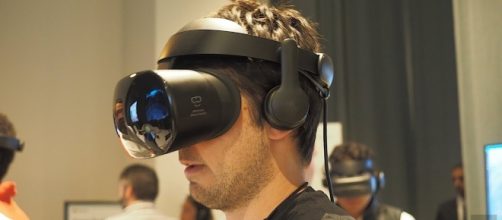News on the latest developments in virtual reality tech does not often make significant waves, but a breakthrough by a major name in the tech industry in that field deserves plenty of focus and attention. Last June, Samsung was reported to be in the development of a VR headset with some fairly impressive specs like a 2,000 ppi display.
Information coming in the following months revealed that the headset would be using Microsoft’s Windows Mixed Reality (WMR) platform. Finally, this Tuesday Microsoft held an event in San Francisco to hype up its WMR applications.
In addition to a series of impressive VR live demos, the Samsung headset is also officially introduced with its final brand name, the Odyssey.
Samsung does VR
The Windows Mixed Reality event by Microsoft on October 3 saw the debut of Samsung’s biggest foray into the virtual reality market yet, in the HMD Odyssey headset. Presentation of the new VR device was made in a press demo room specially set aside for the South Korean electronics giant. To showcase the HMD Odyssey’s capabilities the demonstration unit was running a virtual experience from Microsoft’s first-person shooter franchise “Halo,” a VR spinoff called “Halo Recruit.”
Samsung’s HMD Odyssey has been made available for pre-order on that same day, priced at $499 per unit and expected to start shipping early next month.
In addition to its use of the Window Mixed Reality system and the promised “highest display resolution in the VR industry,” the new headset comes with built-in microphones, precise position sensors, and AKG headphones. The resolution quality is achieved using dual AMOLED displays, technology imported by Samsung from its main consumer electronics product, smartphones.
Taking on Oculus VR
With the entry of the HMD Odyssey into the virtual reality arena, Samsung appears to be issuing a challenge to the leading branded device in the industry, the Rift headset from Facebook subsidiary Oculus VR. Then again, the Korean company is going to have a tough road ahead, given that the Oculus Rift has had years to build up a library of VR games and cinematic adventures plus massive support from Facebook.
What the Odyssey does have over Oculus is a greater degree of accessibility, with the headset having both inside-out positional tracking and motion controllers to keep track of its user’s body and hands for VR interaction, while the Rift requires a PC connection with lots of cables.
The Odyssey is but one of many VR devices that are being developed using Windows Mixed Reality. Microsoft has partnered with other manufacturers aside from Samsung such as Dell, Acer, Lenovo and HP to push the platform, which is being touted as a blending of traditional VR and augmented reality potential.


